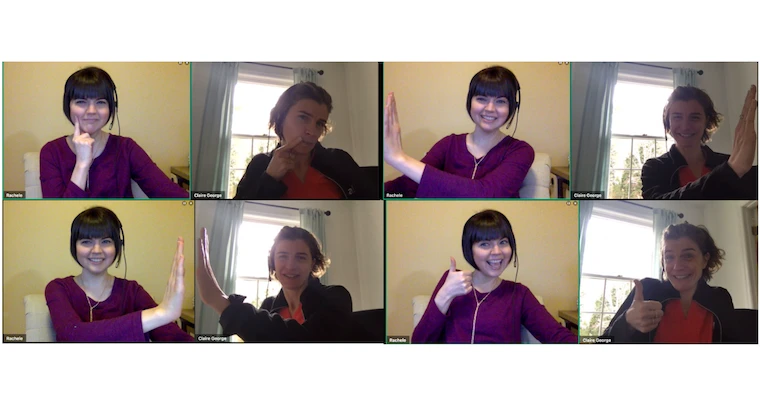
Why We Do Not Have "Zoom Fatigue"
"Can you hear me?" "Are you muted?" "Did we lose them?" You are likely tired of hearing these questions that working remotely over the last year has led to. The pandemic forced millions of people around the world to adjust to new ways of interacting. In the process, many folks have discovered that staring at coworkers on a screen for the majority of the day can be exhausting.
Video conferencing enables us to connect and collaborate in real time — so why are so many struggling with "Zoom fatigue?"
I understand why so many people feel almost at a breaking point. It is not just work meetings that are still happening virtually — even non-work interactions are too. For more than a year, we have attended health appointments, exercise classes, and virtual dinners with family and friends over video calls. Recent research points to why interacting this way can be especially draining.
The reason is "nonverbal overload." Our brains are simply not used to the prolonged eye-contact, intense concentration, and exaggerated gestures that communicating on screen requires. Some companies that only recently switched to remote work have struggled to adopt in-person work habits to a distributed setting. I have heard of a few that switched to audio-only meetings or banned video conferencing on certain days of the week. But the problem runs deeper than video meetings.
I am going to make a bold statement: The issue is not with screen time. It is the result of something deeper and more insidious.
Video calls are not to blame. If your team feels rudderless, it is shortsighted to pin it all on a move out of the office and into your home. The reality is that, while many of us are feeling the pangs of a year of uncertainty and pain, some teams have been able to thrive and achieve great things together. So what is the difference?
Maybe you relied on chatting with coworkers over a lunch break or lingering at someone's desk to get work done. Going remote quickly reveals any dysfunction. Communication silos, a lack of cross-functional cooperation, and circuitous workflows can destroy productivity and sour morale. And if there is no clear plan in place for what you are working on, it can feel as if you are drowning in quicksand — alone.
We take a goal-first approach to everything we do at Aha! This means having a strong vision and making sure the entire team understands what we are trying to accomplish. We have also been entirely remote since the company was founded in 2013, so we understand how essential it is to bake transparency and structure into our work. It is clear where we are headed and how we will collaborate to achieve our goals — no matter where we work from.
If you are feeling drained by a still-fumbling transition to remote work, there are steps you can take to recenter yourself and engage more productively with teammates:
Clear vision
Unity around common goals is especially important for remote teams to feel connected. Everyone should grasp how each person's work contributes to the company and functional goals. If you are struggling to understand why you are working on something, talk to your manager. Try to set individual goals that connect to higher-level team or organizational objectives, then use those to triage and prioritize your work. Share your approach with teammates and encourage them to do the same.
Transparent workflows
What is the status? Who is responsible? What are the next steps? Since you cannot stop by a colleague's desk to ask for an update or remind them of a deadline, your team might default to more meeting time to manage projects. See if you can create templates for regular work and encourage greater transparency across the team. Our team at Aha! establishes repeatable workflows and we use our own software for planning — so everyone has visibility into the work. This increases efficiency and cuts down on status update meetings.
Intentional time
Too many meetings can leave you with little time for deep thinking or intense work. Our team tries to be judicious about scheduling meetings. The time that we do spend together is typically for discussing strategic plans or pushing critical work forward. We also limit each meeting to no more than an hour. You likely do not have total control over your schedule, but you can still influence the video calls you attend. Create an agenda that can keep meetings succinct and on track, and speak up when the conversation loses focus. If someone sends you an invite, be curious and ask what they hope to accomplish. You might be able to avoid gathering everyone together for something that can be solved quickly.
Building meaningful connections with others is important to happiness at work too — this is true whether you are communicating in person or over video.
And virtual meetings can never fully replace being in person. That is why our entire team normally meets twice a year at our onsites. We are able to share fantastic meals, enjoy impromptu conversations, and forge deep connections that sustain us through the next six months. While we have held a few successful virtual team-building events over the last year, we cannot wait to see each other again in person soon.
As the world reopens, everyone is looking forward to decreasing the amount of time we spend staring at a screen to interact with others. But I think remote work and virtual meetings are here to stay. If you are a leader in title or action, now is the time to think critically about how to improve your culture and workflows.
How are you avoiding "Zoom fatigue"?
We love working remotely — you will too. Join our team.




